 |
Welcome To Evlithium Best Store For Lithium Iron Phosphate (LiFePO4) Battery |
 |

In a hyper-connected world, keeping your electronic devices powered up is more important than ever. Whether you're commuting, traveling off-grid, or tackling long workdays, a dependable portable charging solution is crucial. While many people use the terms portable battery charger and power bank interchangeably, they’re not exactly the same.
So what’s the real difference between these two? Let’s break it down.
A portable battery charger is a broad category that includes any mobile device capable of charging electronics, such as solar chargers, car jump starters, and power banks.
A power bank, on the other hand, is a specific type of portable charger equipped with an internal battery that stores energy for later use—without requiring a live power source.
A portable battery charger refers to any device that can recharge another device on the go. This umbrella term includes various technologies designed for different use cases.
Types of portable battery chargers:
Power banks: Compact battery packs for mobile devices.
Solar chargers: Use photovoltaic cells to generate electricity.
Car battery chargers: Designed to recharge or jump-start vehicle batteries.
Laptop battery packs: High-output chargers built for laptops and other power-hungry gear.
Key characteristics:
May feature multiple power input options (USB, AC, solar, etc.)
May or may not have an internal battery.
Suitable for various devices—from smartphones to cars.
Often includes added features like wireless charging or multiple ports.

A power bank is a type of portable charger that contains a rechargeable internal battery. It stores electrical energy and releases it to your devices when needed.
Core features:
Always includes an internal battery.
Capacity typically ranges from 5,000mAh to 50,000mAh.
Offers USB or wireless outputs.
Designed for smartphones, tablets, headphones, and more.
Both devices transfer stored or generated energy to your electronics—but they function differently.
A power bank must be pre-charged and stores energy until it’s needed.
A portable battery charger may function with or without internal energy storage (e.g., a solar charger that provides energy directly from sunlight).
| Feature | Portable Battery Charger | Power Bank |
|---|---|---|
| Internal battery | Optional | Always included |
| Requires live power source | Sometimes | No |
| Best for | Laptops, cars, outdoor activities | Smartphones, tablets, daily carry |
| Charging methods | Solar, car plug, USB, AC | USB, wireless |
| Capacity range | 5,000mAh – 1,000,000mAh | 5,000mAh – 50,000mAh |
Summary of key differences:
Internal Battery – Power banks always have one; portable chargers may not.
Power Source – Power banks are independent once charged; other chargers may need a power source.
Capacity & Usage – Power banks serve mobile electronics; other chargers can power laptops, even vehicles.
Use Case – Power banks suit everyday use; other chargers are great for emergencies or heavy-duty needs.
Your ideal option depends on your lifestyle and charging needs:
Choose a power bank if you want a lightweight, grab-and-go solution for your phone or tablet.
Choose a portable battery charger if you need to power larger devices, recharge in off-grid scenarios, or require different input/output options.
Here’s a closer look at the most popular portable charging options:
Power Banks: Compact, portable, ideal for phones and wearables.
Solar Chargers: Eco-friendly and great for outdoor adventures.
Car Battery Chargers: Heavy-duty chargers capable of jump-starting vehicles.
Laptop Battery Packs: High-capacity chargers designed for productivity on the go.
Before buying, consider the following:
Battery Capacity (mAh or Wh): Determines how much power it holds.
Charging Speed (W or A): Impacts how fast your device recharges.
Portability: Choose a compact model for daily use or travel.
Number of Ports: Useful for charging multiple devices at once.
Durability: Waterproof or rugged designs are ideal for harsh environments.
Portable Battery Charger Pros:
Highly versatile
Charges a wide range of devices
Multiple input power sources
Cons:
Some models require a live power source
Power Bank Pros:
Convenient and compact
Stores energy for off-grid use
Great for travel and emergencies
Cons:
Limited to device size and battery capacity
Q: What’s the core difference between a power bank and a portable battery charger?
A: A power bank always includes a built-in battery, while a portable battery charger may also include solar or automotive options without stored energy.
Q: Can I charge a device while charging the power bank?
A: Yes—most support pass-through charging, though it may reduce efficiency over time.
Q: How long does a power bank last?
A: Typically 300–500 charge cycles, or 2–3 years depending on usage.
Q: Are power banks allowed on planes?
A: Yes, usually under 100Wh is permitted in carry-on baggage. Check your airline’s specific policy.
Q: Can a power bank charge a laptop?
A: Only high-capacity models with USB-C PD support can charge laptops.
Edit by paco
All Rights reserved © 2025 Evlithium Limited